Caballero B. (ed.) Encyclopaedia of Food Science, Food Technology and Nutrition. Ten-Volume Set
Подождите немного. Документ загружается.


plantings were started in Ceylon (now Sri Lanka)
during the 1870s. The cultivation of tea has since
spread to other Asian countries, such as Turkey,
Iran, Taiwan, Bangladesh, and Malaysia. In the late
nineteenth century, cultivation of tea spread beyond
Asia to Africa and South America. Tea was first intro-
duced into Malawi in 1886 and into East Africa at the
beginning of the twentieth century. Production of tea
in the former Soviet Union began on a large scale in
1892. Today, tea is grown in over 30 countries. The
most northerly region in which tea is grown today is
Georgia, in south Russia, and the southernmost is
South Africa, and the Argentine in South America.
Classification
0003 The tea plant, Camellia sinensis (L.) O. Kuntze, is the
only important economic species of the family Thea-
ceae. Two botanical varieties have been recognized.
China Teas (
Camellia sinensis
var.
sinensis
)
0004 These teas are produced from slow-growing, dwarf
trees (which grow to a height of 4–6 m if unattended),
with small, erect, comparatively narrow, markedly
serrated, dark green leaves which are smooth with a
matt surface; the flowers are borne singly. The plant is
relatively resistant to cold and, as a result, the variety
is found in the more temperate producing regions
such as China, Japan, the former Soviet Union,
Turkey, Iran, and the northern, higher-altitude grow-
ing areas of India. It is known to produce delicately
flavored tea when grown at high altitudes; it is, how-
ever, low-yielding, especially at very high altitudes,
such as Darjeeling.
Assam Teas (
Camellia sinensis
var.
assamica
)
0005 This variety is faster-growing and taller (12–15 m
unattended) than the China variety with larger
glossy elliptical leaves; flowers are found in clusters
of 2–4. This variety is less resistant to cold than the
China type and, as such, can only survive at high
altitudes near the Equator. In general, it is a much
higher-yielding plant than the China type, and pro-
duces a less delicately flavored beverage.
0006 Numerous hybrids between China and Assam
types are known. There is evidence that C. irrawa-
diensis was hybridized with C. sinensis var. assamica
to produce the uniquely flavored Darjeeling tea. As
tea is largely cross-pollinated, and much of the com-
mercial crop is raised from seed, the crop is very
heterogeneous.
0007 The term ’jat’ is used to indicate seed derived from
different districts or plantations or to separate types
on the basis of foliar characteristics.
Types of Processed Tea
Fermented or Black Tea
0008Black teas form the major proportion of tea con-
sumed in the western hemisphere. They are produced
by full fermentation and roughly classified as plain or
flavory.
0009Plain black teas are produced and sold on the basis
of the taste characteristics associated with the phen-
olic substances produced during fermentation. These
teas are mainly produced and exported from Africa
(e.g., Kenya and Malawi) and India (Assam). High-
quality plain teas are often known as breakfast teas.
(See Phenolic Compounds; Tea: Chemistry.)
0010Flavory black teas are sold on the basis of their
aroma characteristics and should not be confused
with flavored teas, to which fragrances have been
added. They are primarily manufactured in areas
of relatively high altitude in Sri Lanka and India
(Darjeeling). In Sri Lanka, the very flavory teas are
produced during January and February in the Dim-
bula district, and during August and September in the
Uva district. In these areas, the desired aroma is pro-
duced during cool, clear, dry windy weather with day
and night temperatures of about 20
C and 6–10
C,
respectively. These conditions must last for at least
two consecutive weeks and even slight rain will set the
process back to the beginning. The famed first- and
second-flush Darjeeling flavor is produced under
similar conditions when growth is slow and the plants
are under climatic stress.
Green Tea
0011Green tea is entirely different from black tea in its
preparation. There are no fermentation products and
the leaf remains green. It is generally produced from
var. sinensis. When infused, the liquors are greenish,
pale primrose, or lemon-yellow in color with no trace
of red or brown. Green tea is produced and consumed
mainly in China and Japan. Some is also consumed in
northern Africa. Often, green tea production is a
cottage industry, not only in the countries mentioned
above, but also in other countries such as Malaysia,
Thailand, Vietnam, and Indonesia. This processing is
often undertaken by experienced Chinese tea makers.
(See Tea: Processing.)
0012There are many different kinds of green tea pro-
duced, differing in style and cup characters. Some
varieties of green tea include the following:
.
0013Sencha, the most widely drunk grade of green tea in
Japan.
.
0014Kamaira-cha, made from young leaf, but differing
from sencha in that the first process is parching and
not steaming.
5738 TEA/Types, Production, and Trade

.0015 Bancha, made from coarse leaf and stalk.
.
0016 Gyokuro, one of the finest green teas; it is grown
under complete shade, hand-plucked and hand-
sorted. It has a twisted dark green leaf.
.
0017 Matcha, a powdered tea also made from shade-
grown leaf.
.
0018 Tencha, the ceremonial green tea. The beverage is a
suspension of finely ground leaf.
.
0019 Gunpowder, made in the form of small compact
pellets of Chinese green tea.
.
0020 Pilo chun, a small-leaved Chinese tea made from
the first spring flush.
Partially Fermented Tea
0021 Typical partially fermented teas include oolong and
pouchong teas. These are partially oxidized so that
their appearance is somewhat intermediate between
that of green and black tea. Pouchong teas have a
shorter fermentation time. They are manufactured
primarily in China and Taiwan. Clones selected for
oolong and pouchong tea production are character-
ized by the ability to impart a strong flowery aroma
to the product. (See Tea: Processing.)
Instant Tea
0022 Instant tea is the water-soluble extract of tea leaf,
usually marketed as a powder, flake, or granule,
either pure or as a part of flavored mixes. Iced
lemon teas are the most popular examples of instant
teas, particularly in the USA. Most instant tea is made
from black tea, but some is made from green tea. It is
manufactured in a number of tea-growing countries,
e.g., Kenya and China, where the starting material
may be fermented leaf that has not been dried.
Flavored Teas
0023 Teas are sometimes scented with various plant essen-
tial oils such as lemon, bergamot, rose, and fragrant
olive which impart sweet floral attributes to enhance
the natural flavor of the tea. Other teas are blended
with flower petals, spices, or dried leaf such as chrys-
anthemum, rosemary, camomile, and peppermint.
Floral flavored teas are mainly consumed in the USA
while herbal teas are popular in continental Europe.
Many of these products are sold through health food
stores and may not contain C. sinensis: the word ’tea’
refers to their method of preparation. These products
are often promoted on health grounds, particularly if
they are caffeine-free. (See Essential Oils: Properties
and Uses.)
Decaffeinated Tea
0024 Decaffeinated tea has been popular in the USA since
its introduction in 1983; however, in the UK the
picture has been slightly different. Until the late
1980s it was primarily retailed through health food
outlets; however more recently a number of specialist
tea companies have launched decaffeinated tea bags
into the mainstream grocery trade with considerable
success.
0025Caffeine is removed from tea by treating it with
one of three organic solvents: methylene chloride,
ethyl acetate, or supercritical carbon dioxide. The
caffeine is dissolved in the solvent and the tea is then
treated to remove most of the solvent. (See Coffee:
Decaffeination.)
Organically Grown Tea
0026Organically grown teas from Tanzania first entered
the UK market in 1989 under the Natureland brand
name from the London Herb & Spice Company.
The tea bags were sold at a 20% premium price
over other speciality teas and at more than double
the price of regular tea bags. Since this time other
organically grown tea products have appeared on
the market. The major producers are India and Sri
Lanka.
0027The attraction to the grower is substantially in-
creased price for the crop and the saving of hard
currency on chemical fertilizers and pesticides. It is
believed that the average transition period from con-
ventional to organic culture is 3 years, allowing time
for chemicals to disperse.
World Production
0028According to statistics compiled by the Inter-
national Tea Committee, tea production over the
past decade (1988–98) increased from 2.48 million
metric tons (mt) to 2.96 million mt. This represents
an average annual rate of increase of 1.9%. The
major producers are listed in Figure 1 along with
their average production for the 1995–97 period
and for 1998, the last year for which figures are
currently available. The 3-year averages have been
included to reveal the trend of changes in pro-
duction through the smoothing of year-to-year
fluctuations.
0029India is currently ranked as the world’s largest
producer of tea, followed by China, Kenya, and Sri
Lanka. Kenya in particular had a record production
for 1998 that represents an increase of over 33.3%
from the 1997 drought-affected crop. Increases in
both yields and planted area are likely to continue
to support strong growth in tea production in Afri-
can countries where the Kenyan output is expected
to increase at an average annual rate of 2.8%.
Malawi, Tanzania, and Zimbabwe are also expected
TEA/Types, Production, and Trade 5739
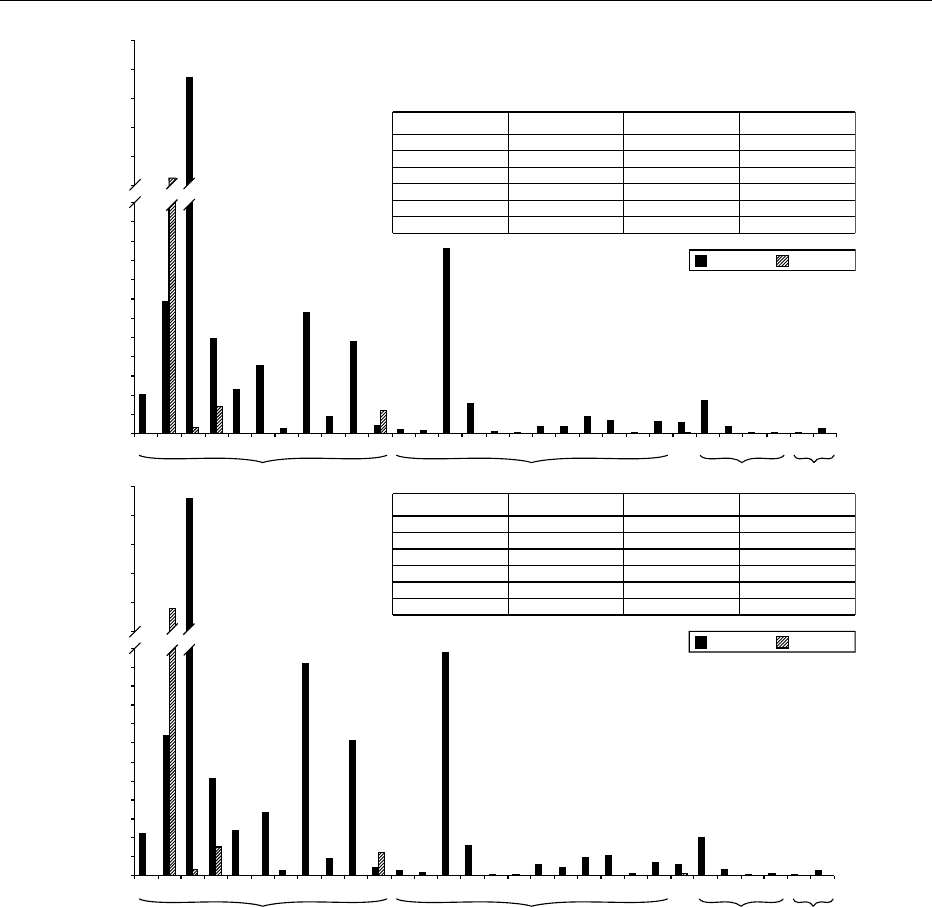
to increase production significantly. The Intergov-
ernmental Group (IGG) on Tea of the Food and
Agriculture Organization (FAO) of the United
Nations predicts that production in India will
reach 1.02 mt in 2005. Economic reforms and the
national plan to expand tea production in Sri Lanka
could boost production to 285 000 mt, compared to
157 800 mt during the 1995–97 period. Other major
tea-producing countries, including China and Indo-
nesia, should also see significant growth in production,
while in Bangladesh production is forecast to grow
less rapidly.
0030Production expansion programs initiated by
major exporting countries have contributed to pre-
vious increases in output of black tea in recent
years, and the impact of these programs, particularly
as bushes reach optimum production age, may
continue.
0031The total tea area under production has increased
from 1.4 million hectares in 1961 to 2.3 million
0
25
50
75
100
125
150
175
200
225
250
275
300
Ba
0.3
7.8
6.2 5.6 3.9
2.7 1.6 2.5
9.0
1.9
2.5 1.0
6.7
8.9 9.4
0.5 X
Ch Ia In Ir Jp My SL Tw Tk Vt Bu Cm Ky Mw Mr Mz Rw SA Tz Ug Za Zw Ag Br Ec Pr Au PG
2.3
CIS
400
500
600
700
800
900
a
b
b
b
b
b
b
b
b
bb
b
Region
Asia
Africa
CIS
South America
Oceania
World
1582.7
370.0
14.7
56.8
7.7
2031.9
500.0
0.0
2.3
0.0
0.0
595.9
2082.7
370.0
17.0
56.8
7.7
2627.8
Black Tea Green Tea Total
Asia Africa
World production of black and green teas for the year 1995−97
South America
Oceania
Black Tea Green Tea
0
25
50
75
100
125
150
175
200
225
250
275
300
Ba Ch Ia In Ir Jp My SL Tw Tk Vt Bu Cm Ky Mw Mr Mz Rw SA Tz Ug Za Zw Ag Br Ec Pr Au PG
400
500
600
700
800
900
a
X
0.2
8.6
6.3
0.6
6.7 4.7
1.5
1.6 2.5
8.0
1.9 2.4
1.3
6.0
CIS
3.6
Asia Africa
South America
Oceania
Region
Asia
Africa
CIS
South America
Oceania
World
1788.0
445.7
14.4
62.3
7.3
2317.7
641.2
0.0
3.6
0.0
0.0
644.9
2429.2
445.7
18.0
62.3
7.3
2962.6
Black Tea Green Tea Total
World production of black and green teas for the year 1998
b
b
b
b
b
b
b
b
b
b
b
b
b
b
b
b
bb
b
Black Tea Green Tea
fig0001 Figure 1 World production of black and green teas for the 1995–97 period and 1998 (1000 Mt).
a
Black and other teas, but not green
teas.
b
Figures shown are provisional or estimated. CIS: Commonwealth of independent states (former Union of Soviet Socialist
Republics), Ba: Bangladesh, Ch: China, Ia: India, In: Indonesia, Ir: Iran, Jp: Japan, My: Malaysia, SL: Sri Lanka, Tw: Taiwan, Tk: Turkey,
Vt: Vietnam, Bu: Burundi, Cm: Cameroon, Ky: Kenya, Mw: Malawi, Mr: Mauritius, Mz: Mozambique, Rw: Rwanda, SA: South Africa, Tz:
Tanzania, Ug: Uganda, Za: Zaire, Zw: Zimbabwe, Ag: Argentina, Br: Brazil, Ec: Ecuador, Pr: Peru, Au: Australia, PG: Papua New
Guinea. Data from the Annual Bulletin of Statistics (2000).
5740 TEA/Types, Production, and Trade

hectares in 1996. The average yield per hectare has
increased by over 50% during the same period. How-
ever, it is questionable whether any large-scale in-
creases will ensue from now on.
World Trade
Tea Retained in Producing Countries
0032 In 1998, over 57% of the world’s production of tea
was retained in producer countries. In some countries
it was much higher: Over 76% of the Indian and 74%
of the Chinese production is retained for internal
consumption. For India, in particular, the home
market has increased greatly from 499 053 mt
(1988) to 667 565 mt (1998). For a number of other
countries, e.g., Iran, Japan, Malaysia, South Africa,
Taiwan, and the Russian Federation, the majority, if
not all, of their tea produced is consumed internally.
African producer countries generally export the
majority of their production, whereas most Asian
producers do not.
Exports
0033 World exports of tea, both black and green, for the
1995–97 period and for 1998 are reported in Figure 2.
All major exporting countries maintained significant
export volumes for 1998. The FAO projects that net
export availabilities will reach 1.292 million mt in
2005 and predicts that China, India, Indonesia,
Sri Lanka, and Kenya will account for 78% of this
increased volume. Bangladesh, Malawi, Tanzania,
Turkey, and Zimbabwe are also expected to increase
their export capabilities significantly by 2005.
Exports from India, the world’s largest tea-producing
and -consuming country, are expected to recover
from the recent disappointing performance due to
weather, while satisfying growing domestic demand.
0034 The largest and most significant exporter of green
tea is China. Major destinations for green tea include
Morocco, the Russian Federation, Algeria, the USA,
and Afghanistan. India exports small amounts of
green tea to the USA, Afghanistan, and Japan.
China also produces a number of other teas, e.g.,
partially fermented, and the major export destin-
ations for these are Hong Kong and Japan. Taiwan
produces and exports oolong, pouchong, and green
tea, with Japan being the largest importer of these.
The Japanese, in turn, export a small proportion of
their green teas, primarily to the USA.
Imports
0035 Imports for Consumption Figure 3 shows tea im-
ports for consumption of major importing countries
for the 1995–97 period and for 1998. The UK and the
Confederation of Independent States (CIS) countries
– particularly the Russian Federation – were the larg-
est importers of tea for internal consumption. Other
major destinations for tea include Pakistan, the USA,
Egypt, Japan, Iraq, and Morocco. Growth in de-
veloped countries is expected to be largely concen-
trated in the CIS countries, the USA, and, to a lesser
extent, western Europe. Consumption in the UK has
been declining since 1961 when consumption per
head was 4.5 kg, and reached its lowest point of
2.4 kg in 1995. The FAO reports that the apparent
consumption per head has since stabilized and rose
to 2.49 kg in 1996 and 2.58 kg in 1997. This is re-
flected in consecutive increases in net imports for
these years.
0036Reexports of tea A proportion of the tea imported
into the UK is reexported. The largest recipients of
this reexported tea are Canada, Germany, Saudi
Arabia, and France. The Netherlands also reexports
a high proportion of its imports.
Marketing
0037Most of the world’s black tea production is traded
in either auction or forward markets. The former
accounts for the largest proportion of the total tea
traded. In 1997, 84% of the total tea traded was
sold through auctions held in producer countries,
namely: Mombasa (Kenya), Guwahati, (India),
Siliguri (India), Calcutta (India), Cochin (India),
Coimbatore (India), Chittagong (Bangladesh), Col-
ombo (Sri Lanka), Jakarta (Indonesia), and Limbe
(Malawi). The auctions take place weekly through
the growing season.
0038Tea sold through forward contracts is gaining
popularity. A significant advantage of this market
over the auction market is that the participants can
lock on prices they wish to trade in the future. In the
forward market, a buyer and a seller buy/sell an
agreed amount of goods for delivery on an agreed
future date at a predetermined price. Prices in this
market tend to be less transparent than auction prices
(spot or cash markets).
Tea Consumption
0039According to the FAO, black tea consumption will
increase from 1.97 million mt in 1993–95 to 2.67
million Mt by 2005 – an annual growth rate of
2.8%. Statistics collated by the International Tea
Committee indicate that this is an underestimation,
as the total world production for 1998 exceeds
the FAO estimate for 2005. Developing countries
are forecast to account for the largest part of the
TEA/Types, Production, and Trade 5741
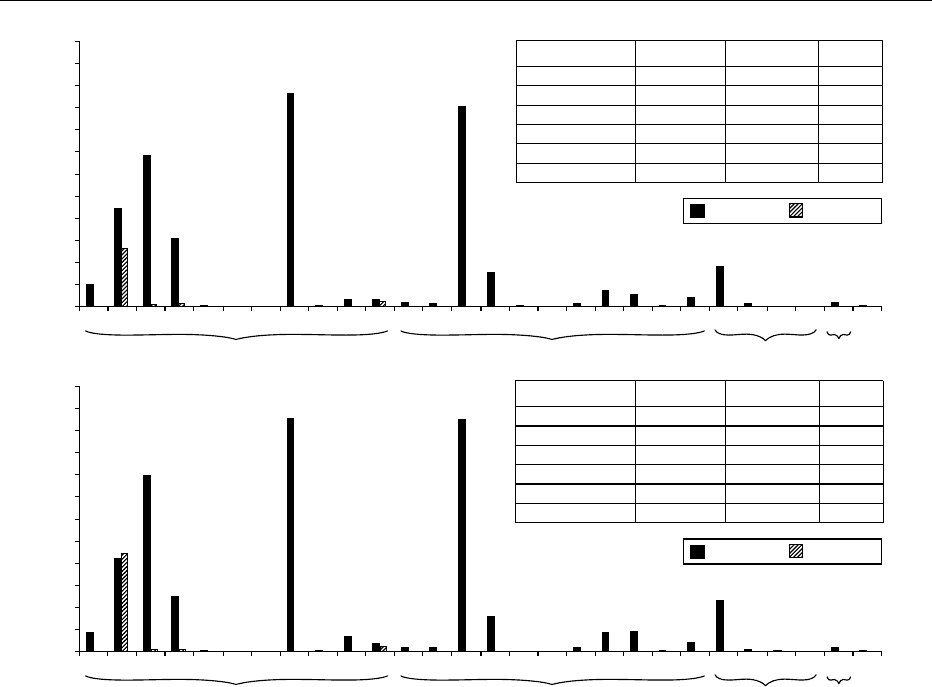
prospective increase, with consumption rising from
the 1993–95 average of 1.41 million mt to 1.95 mil-
lion Mt by 2005 – an annual growth rate of 3%.
0040 The FAO reports that black tea consumption in
India will rise rapidly, reaching 832 000 Mt by
2005, annual growth of 3.2% from the 1993–95
average. In other major markets for black teas, such
as Pakistan, the Islamic Republic of Iran, and Egypt,
consumption is projected at 160 000 Mt, 122 000 Mt,
and 90 000 mt by 2005, respectively. The reduction of
import tariffs and declining prices could have a more
pronounced effect on consumption in these countries.
0041 Consumption in the European Community is pro-
jected to increase only slightly in the next decade since
higher purchases by France, Germany, Italy, and the
Netherlands would be largely counterbalanced by the
decline in consumption in the UK that began in 1961.
Consumption in the USA is projected to increase,
though at a relatively slow rate of less than 1%. In
the countries of the former Soviet Union, black tea
consumption is projected to increase from 154 000 mt
in 1993–95 to 250 000 mt in 2005, equivalent to an
annual growth rate of 4.5%.
Trends in World Supply, Demand, and Prices
0042The FAO projections indicate that, by 2005, world
black tea production and consumption could almost
be in balance. Production gains are expected to come
largely from higher yields, while the rise in consump-
tion is from population and income growth. Develop-
ing countries are expected to account for most of
the growth and their share in world consumption is
expected to rise by 2% 2005. However, much
will depend on the economic development of these
countries.
0
25
50
75
100
125
150
175
200
225
250
275
300
Ba
a
8.5
6.6
9.2
5.6
4.0
0.5
4.0
2.0
b
b
b
b
b
b
4.8
1.15
0.1
b
b
b
b
5.8
1.8
1.6
3.0
4.0
1.9
0.6
2.3
0.9
0.5 0.5
Ch Ia In Ir Jp My SL Tw Tk Vt Bu Cm Ky Mw Mr Mz Rw Tz Ug Za Zw Ag Br Ec Pr PG Oth
Region
Asia
Africa
South America
Oceania
Other Countries
World
652.1
328.5
52.3
5.8
1.8
1040.4
82.8
0.0
0.0
0.0
0.0
82.6
734.8
328.5
52.3
5.8
1.8
1123.0
Black Tea Green Tea Total
World export of black and green teas
for the year 1995−97
Black Tea
Green Tea
Asia Africa South America Oceania
Other
Countries
0
25
50
75
100
125
150
175
200
225
250
275
300
Ba Ch Ia In Ir Jp My SL Tw Tk Vt Bu Cm Ky Mw Mr Mz Rw Tz Ug Za Zw Ag Br Ec Pr PG Oth
Region
Asia
Africa
South America
Oceania
Other countries
World
688.8
379.5
63.6
5.3
1.8
1139.0
126.5
0.0
0.0
0.0
0.0
126.5
815.3
379.5
63.6
5.3
1.8
1265.5
Black Tea Green Tea Total
World export of black and green teas
for the year 1998
Asia Africa South America Oceania
Other
Countries
a
b
b
b
b
b
b
9.7
6.8
5.8
4.9
0.5
5.0
2.0
3.2
1.2 0.2
bbb
b
b
5.3
1.8
0.2
b
b
b
b
b
3.0
3.5
2.5
0.1
0.6
0.5
2.1
0.4
0.6
b
b
Black Tea
Green Tea
fig0002 Figure 2 World export of tea (black and green) for the 1995–97 period and 1998 (1000 Mt).
a
Black and other teas, but not green teas.
b
Figures shown are provisional or estimated. Ba: Bangladesh, Ch: China, Ia: India, In: Indonesia, Ir: Iran, Jp: Japan, My: Malaysia,
SL: Sri Lanka, Tw: Taiwan, Tk: Turkey, Vt: Vietnam, Bu: Burundi, Cm: Cameroon, Ky: Kenya, Mw: Malawi, Mr: Mauritius,
Mz: Mozambique, Rw: Rwanda, Tz: Tanzania, Ug: Uganda, Za: Zaire, Zw: Zimbabwe, Ag: Argentina, Br: Brazil, Ec: Ecuador,
Pr: Peru, PG: Papua New Guinea. Data from the Annual Bulletin of Statistics (2000).
5742 TEA/Types, Production, and Trade
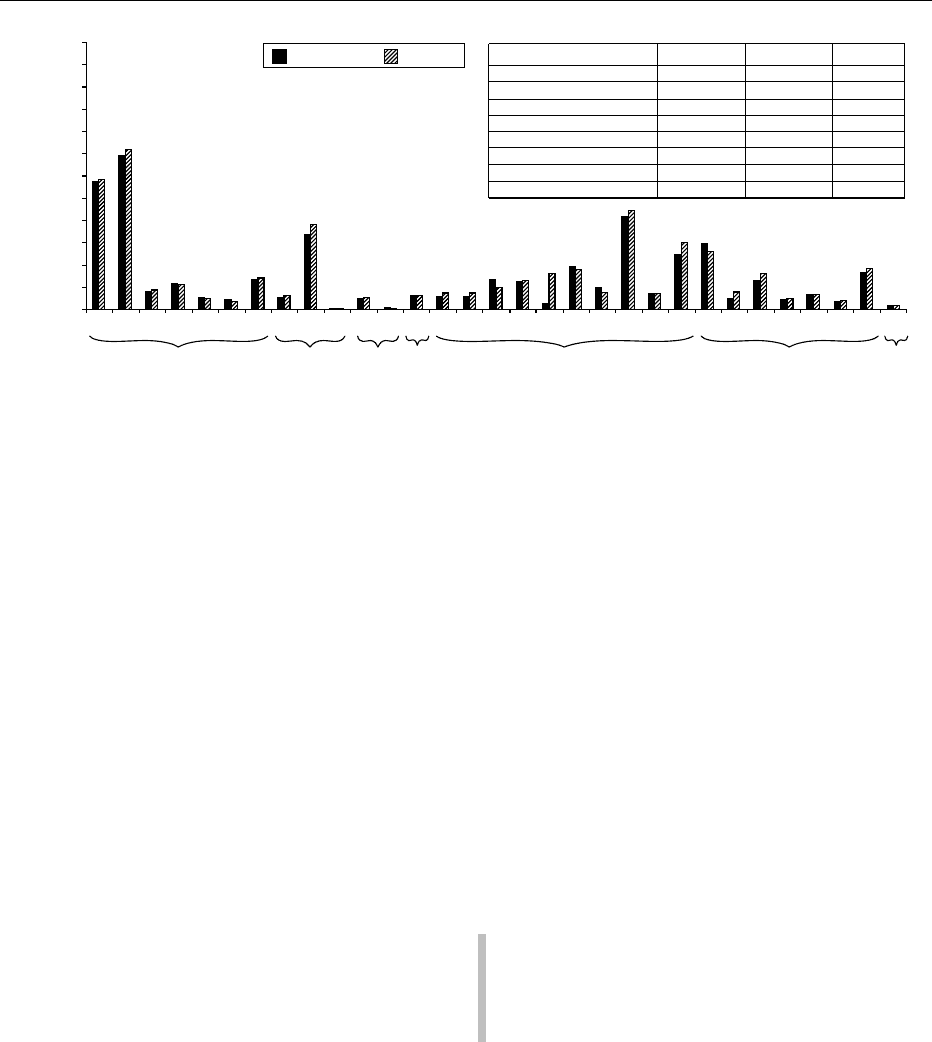
0043 The FAO projections suggest an imbalance in the
international market, with a surplus of export avail-
abilities over import requirements, reaching
24 000 Mt by 2005 from an almost balanced market
in 1993–95. This possible imbalance implies that
world market prices would be under downward pres-
sure if there were no additional increase in demand
and/or downward adjustments in production. One of
the ways to narrow the trade deficit and improve
prices is to expand consumption through promotion.
Over the last few years, the IGG on Tea has made
major efforts to create awareness of the health bene-
fits of tea drinking and to work out a generic promo-
tion program that would stimulate consumption of
tea.
0044 The FAO reports that auction prices of black tea
rose significantly during the first quarter of 1998;
however they failed to maintain this vigor during
the remainder of the year. Tea prices were boosted
in 1997 and early 1998 by reports of drought-induced
damage to the crops in Kenya and Indonesia, as well
as strong import demand in the former Soviet Union.
However, following the production recovery in
Kenya, and to a lesser extent in Indonesia, coupled
with a sharp drop in import demand from the Russian
Federation due to deterioration of economic condi-
tions, prices weakened significantly during 1998.
See also: Coffee: Decaffeination; Essential Oils:
Properties and Uses; Phenolic Compounds; Tea:
Chemistry; Processing
Further Reading
Anonymous (1999) Committee on Commodity Problems.
Intergovernmental Group on Tea. Thirteenth Session.
Food and Agriculture Organization of the United
Nations. Ottawa, Canada, 27–29 September 1999.
Anonymous (2000) Annual Bulletin of Statistics. London:
International Tea Committee.
Purseglove JW (1986) Tropical Crops. Dicotyledons.
London: Longman.
Willson KC and Clifford MN (1992) Tea. London:
Chapman & Hall.
Chemistry
P O Owuor, Tea Research Foundation of Kenya,
Kericho, Kenya
Copyright 2003, Elsevier Science Ltd. All Rights Reserved.
Tea
0001Tea beverages are processed from the young tender
shoots of Camellia sinensis (L) O. Kuntze. The plant
biosynthesizes several chemicals during growth.
Table 1 summarizes the approximate chemical com-
position of dry tea leaves. The polyphenols, domin-
ated by catechins (or flavan-3-ols) constitute up to
32% of the dry weight of young tender shoots. The
tender tea plant shoots also contain both saturated
and unsaturated fatty acids, either as glycosides or as
0
25
50
75
100
125
150
175
200
225
250
275
300
UK
9.4
a
a
a
a
a
a
a
a
a
a
a
a
a
a
a
a
aa
a
1.3 1.4
2.8
7.1
5.2 5.5
2.6
CIS G Po Fr Ir OE Ca US WI Ch OL Au Du Su Af Ir Iq Jp Jo Pk Sy OAs Eg Lb Mo SA Su Tu OAf
Oth
Region
Europe
North America/West Indies
Latin America
Oceania
Asia
Africa
430.0
100.3
15.9
16.6
363.8
203.7
436.7
115.1
16.7
16.7
409.9
215.1
866.7
215.4
32.6
33.3
773.7
418.8
Other Countries 21.8 22.2 44.0
World 1090.6 1215.7 2306.3
1995-97 1998 Total
Europe North America/
West Indies
Tea imports for consumption for selected
countries for the year 1995−97 and 1998
Africa Other
countries
Latin
America
Oceania Asia
Yr. 1995−97 Yr. 1998
fig0003 Figure 3 Tea imports for consumption for selected countries for the 1995–97 period and 1998 (1000 Mt) (imports adjusted for re-
exports).
a
Figures shown are provisional or estimated. UK: United Kingdom, CIS: Commonwealth of independent states (former
Union of Soviet Socialist Republics), G: Germany, Po: Poland, Fr: France, Ir: Ireland, OE: Other European countries, Ca: Canada,
US: United States of America, WI: West Indies, Ch: Chile, OL: Other Latin American countries, Au: Australia, Du: Dubai, Su: Saudi
Arabia, Af: Afghanistan, Ir: Iran, Iq: Iraq, Jp: Japan, Jo: Jordan, Pk: Pakistan, Sy: Syria, OAs: Other Asian countries, Eg: Egypt, Lb: Libya,
Mo: Morrocco, SA: South Africa, Su: Sudan, Tu: Tunisia, OAf: Other African countries. Data from the Annual Bulletin of Statistics (2000).
TEA/Chemistry 5743

free acids. There are also methlyxanthines (mainly
caffeine), amino acids and proteins, terpenes, and
terpene glycosides, and many endogenous primary
volatile flavor compounds. Although the biosynthetic
pathways of these compounds are interesting, only
the chemical and biochemical processes (after the
young tender shoots have been plucked to make
various kinds of tea beverages) are discussed here.
0002 Of the many tea beverages, the most extensive
chemical transformations occur during black tea pro-
cessing. The article shall therefore reflect the chemis-
try of tea as represented by black tea manufacture,
although, these chemical reactions partially occur
to different degrees in the processing of other tea
beverages.
Polyphenols
0003 Polyphenols play a key role in the chemistry of the
formation of the nonvolatile components of black
tea. Although attempts to understand the chemistry
of the formation of the nonvolatile black tea compon-
ents started over half a century ago, to date, the
chemistry is only partially understood. The young
tender shoots of the tea plant used to process tea
beverages contain high amounts of polyphenols,
comprising flavanols (catechins), flavanol glycosides,
leucoanthocyanins, and phenolic acids, etc.
0004The dominant polyphenols in green leaf are flavanol
(Figure 1) comprising (þ)-catechin (C), (þ)-gallocate-
chin (GC), ()-epicatechin (EC), ()-epigallocatechin
(EGC) and ()-epigallocatechin gallate (EGCG).
These compounds dominate the chemistry of non-
volatile compounds in tea. Several factors, including
climate, genetic make-up, age of shoots and agro-
nomic practices, cause variations in the total amounts
and ratio of these compounds in young tea shoots.
Although, recently, ()-epicatechin-3,5-digallate and
3-methylgallates of ()-epicatechin and epigallo-
catechin have been isolated in green tea leaves, their
chemistry with respect to tea processing remains un-
known. (þ)-Catechin-3-gallate (CG) and (þ)-gallo-
catechin-3-gallate (GCG) have also been isolated in
manufactured teas, but not from fresh leaves. They
are likely products of epimerization or racemization
caused by firing (drying).
0005The other important component in the chemistry of
nonvolatile components of tea is polyphenol oxidase.
This is an o-dihidroxyphenolic oxygen reductase
enzyme leading to the production of o-quinones.
The enzyme is abundant in young tender shoots of
green tea leaves, especially those cultivars suitable for
making black teas.
0006The most noticeable chemical transformations/
changes occur during the fermentation phase of black
tea processing. Although this stage is called fermenta-
tion, in the true sense, the reactions that occur are
those of oxidation. Following cell matrix destruction
brought about by maceration, the catechins (flava-
nols) and other polyphenols undergo polyphenol
oxidase initiated reactions, forming brown-colored
products. The 1,2-dihydoxyphenols are oxidized to
the quinones in the presence of oxygen, reacting fur-
ther to form various brownish compounds. A simple
catechin and a gallocatechin, for example, undergo
oxidative reactions, which involve a loss of carbon
dioxide to form a benzotropolone ring system. The
compound formed is known as ’theaflavin.’ Figure 2
outlines the formation of theaflavin.
0007From various combinations of the flavanols, it is
possible to produce several theaflavins, as shown in
Table 2. However, the dominant theaflavins found in
black tea are theaflavin, theaflavin-3-gallate, theafla-
vin-3
0
-gallate and theaflavin-3,3
0
-digallate. The pro-
portions of these four theaflavins in black tea vary
with processing conditions and the composition of
the individual precursor flavanols in green leaf.
0008Traces of epitheaflavic acid, theaflavin acid, and
epitheaflavic acid-3
0
-gallate have also been found in
black tea. Normally, there is very little gallic acid in
green leaf. However, during fermentation, its levels
tbl0001 Table 1 Approximate chemical composition of young shoots of
Camellia sinensis var. Assamica
Type Components Dry
weight (%)
Water-soluble Phenolic compounds 40
Flavanols 18–30
Epigallocatechin
gallate
9–13
Epigallocatechin 3–6
Epicatechin gallate 3–6
Epicatechin 1–3
Gallocatechin 1–2
Catechin 1–2
Flavonol glycosides 3–4
Proanthocyanidins 2–3
Phenolic acids 4
Caffeine 3–4
Amino acids 4
Theanine 2
Others 2
Carbohydrates 4
Organic acids 0/5
Partially water-soluble Starch 2–5
Other polysaccharides 12
Proteins 15
Ash 5
Water-insoluble Cellulose 7
Lignin 6
Lipids 4–9
Pigments 0.5
Volatiles 0.01–0.02
5744 TEA/Chemistry
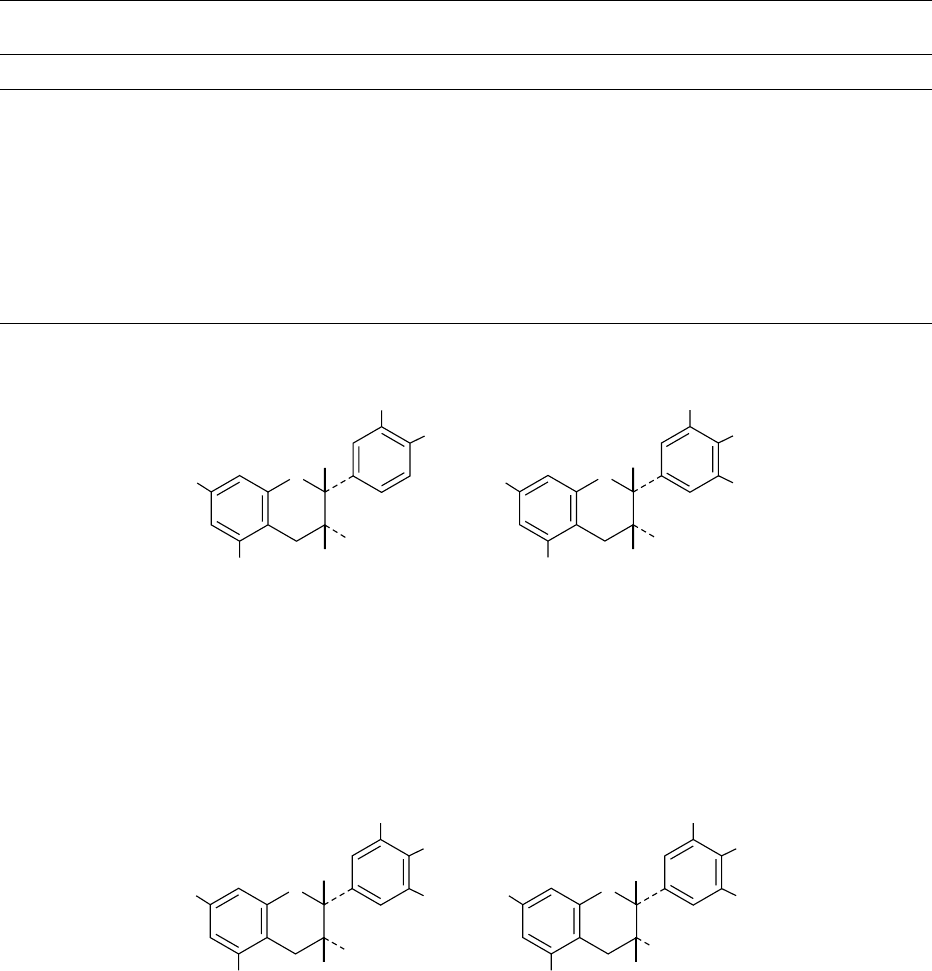
increase, probably from the hydrolysis of galloyl
esters from the catechins or gallated theaflavins. Al-
though the rate of oxidation of gallic acid to the
quinone acid is low, the presence of theaflavic acids
is suspected to originate from gallic acid. Additional
isomers of the theaflavins can also arise from
racemization and epimerization of the flavanols.
However, since racemization and/or epimerization of
flavanols occur mainly during firing, very few isomers
of theaflavins are normally found in black tea.
0009Theaflavins account for 0.3–1.8% dry weight of
black tea and 1–6% of total solids in tea. They are
tbl0002 Table 2 Synthesis of theaflavins from pairs of flavanols
Parent flavanols Theaflavin
Dihydroxy Trihydoxy
()-Epicatechin ()-Epigallocatechin Theaflavin
()-Epicatechin ()-Epigallocatechin gallate Theaflavin-3-gallate
()-Epicatechin gallate ()-Epigallocatechin Theaflavin-3
0
-gallate
()-Epicatechin gallate ()-Epigallocatechin gallate Theaflavin-3,3
0
-digallate
()-Epicatechin (þ)-Gallocatechin Isotheaflavin
(þ)-Catechin (þ)-Gallocatechin Neotheaflavin
()-Epicatechin (þ)-Gallic acid Epitheaflavic acid
()-Epicatechin gallate (þ)-Gallic acid Epitheaflavic acid-3
0
-gallate
(þ)-Catechin (þ)-Gallic acid Theaflavic acid
(þ)-Catechin gallate (þ)-Gallic acid Theaflavic acid-3
0
-gallate
OHO
H
H
OR
OH
OH
R
2
O
OHO
H
H
OR
OH
OH
OH
R
2
O
OHO
H
OR
H
OH
OH
H
HO
O
HO
H
OR
H
OH
OH
H
HO
i (−)-Epicatechin;
ii (−)-Epicatechin-3-gallate;
iii (−)-Epicatechin-3,5-digallate;
R
1
= R
2
= H
R
2
= H
R
1
= 3,4,5-trihydroxy-benzoyl,
R
1
= R
2
= 3,4,5-trihydroxy-benzoyl
vii (+)-Catechin;
R = H
viii (+)-Catechin-3-gallate;
R = 3,4,5-trihydroxy-benzoyl
ix (+)-Gallocatechin;
R = H
x (+)-Gallocatechin-3-gallate;
R = 3,4,5-trihydroxy-benzoyl
iv (−)-Epigallocatechin;
v (−)-Epigallocatechin-3-gallate;
vi (−)-Epigallocatechin-3,5-digallate;
R = R
2
= H
trihydroxybenzoyl, R
2
= H
R
1
= 3,4,5-
R
1
= R
2
= 3,4,5-
trihydroxybenzoyl
fig0001 Figure 1 Structures of dominant flavanols in young tender shoots of tea plants.
TEA/Chemistry 5745
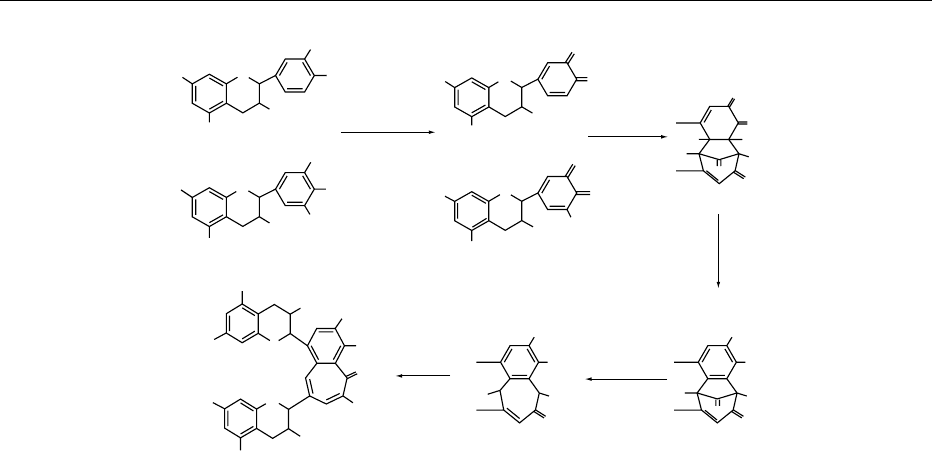
bright red pigments that give the tea liquor its char-
acteristic ’brightness’ and ’briskness’. The contribu-
tions of the individual theaflavins to quality differ,
with the gallated theaflavins being more astringent.
0010 The other set of brownish compounds formed
during black tea processing are called ’thearubigins.’
Despite over 60 years’ research, a full chemical char-
acterization of thearubigins has yet to be achieved.
Indeed, even their contribution to tea quality is not
fully understood. The thearubigins are a group of
compounds, of which some fractions have a large
molecular weight and are nondialyzable compounds.
The mixture of groups of compounds normally called
thearubigins has been identified to have fractions of
polysaccharides, proteins, nucleic acid anthocyani-
dins, cyanidin, and delphinidin. Indeed, the thearubi-
gin structure could be a polymeric proanthocyanidin.
The thearubigins are thought to be polymeric
products of the various polyphenols. Indeed, a 4–8
interflavanoid bonding has been considered possible
after oxidation of catechin. Over 40 peaks represent-
ing pigmented components have been separated by
HPLC from black tea liquor, in the range of expected
thearubigins. With prolonged fermentation, theafla-
vins undergo oxidative degradation. Thus, apart from
thearubigins being formed directly from the cate-
chins, and breakdown of thearubigins, theaflavin
intermediates may also be involved in the coupled
oxidation leading to more thearubigins. Thearubigins
may not be a group of compounds with a common
basic structure. They may be colored compounds
resulting from catechin oxidation, catechin coupling
without benzotropolone ring formation and catechin–
anthocyanidin interactions. Other high-molecular-
weight compounds formed by the interactions
between flavanol quinones with other macromol-
ecules such as proteins, carbohydrates, and nucleic
acids are also classified as thearubigins.
0011The proposed strategy for the formation of thea-
flavins and thearubigins from flavanols is summari-
zed in Figure 3. The formation of one theaflavin
requires one molecule of a simple catechin and a
gallocatechin. Tea shoots normally have higher
amounts of the gallocatechins than of the simple
catechins. This imbalance in the ratio affects the abil-
ity of particular leaves to make theaflavins, and may
direct most gallocatechins to make thearubigins. The
redox potentials of the individual flavanols to quin-
ones also affect the amounts of the particular quinone
available for reaction to produce theaflavin. The
availability of a high polyphenol oxidase activity
and oxygen are therefore critical in the direction of
theaflavins to thearubigins formed under ideal condi-
tions. However, even under ideal conditions, after
some time, the formed theaflavins start degrading
to thearubigins. Resultant thearubigins also degrade
further or polymerize to other thearubigins.
0012Oxygen is required in three key steps: the oxidation
of catechins to quinone, benzotropolone ring forma-
tion, and oxidative degradation of theaflavins. The
first two are necessary for theaflavin formation. For
the formation of high amounts of theaflavins, excess
O
HO
HO
HO
H
O
O
O
HO
O
O
H
H
O
HO
HO
HO
HOOC
HO
HO
HO
HO
HO
HO
HO
HO
HO
HO
HO
HO
HO
HO
HO
HO
HO
HO
HO
HO
OH
OH
OH
OH
OH
OH
OH
O
O
O
O
O
O
O
O
O
O
O
H
(O)
fig0002 Figure 2 Mechanism of theaflavin formation. From Takino Y, Imagawa H, Horikawa H, and Tanaka A (1964) Studies on the
mechanism of oxidation of tea leaf catechins – formation of a reddish/orange pigment and its spectral relationship to some
benzotropolone derivatives. Agricultural Biology and Chemistry 28: 64–71, with permission.
5746 TEA/Chemistry

oxygen should therefore be available. The flavanols
have a high affinity for oxygen. When oxygen is
limiting, the benzotropolone ring system formation
becomes inhibited, and fewer theaflavins are formed.
However, during the theaflavin formation, there is
also competitive degradation of theaflavins. With
excess oxygen and/or when the catechin levels have
been depleted, this reaction can be significant, redu-
cing the amounts of theaflavins, but increasing thea-
rubigins. However, this may not be the only way the
thearubigins are formed. As in any chemical reaction
system, the reaction temperature is critical. Fermen-
tation of temperatures between 15 and 30
Cis
beneficial to theaflavin formation. However, a higher
temperature fermentation facilitates thearubigin
formation at the expense of theaflavins.
0013 Firing terminates the chemical reactions associated
with the formation of the nonvolatile black tea com-
ponents. Firing heat denatures polyphenol oxidase,
reduces the moisture content to a product that can
be stored, and enhances reactions responsible for
black tea aroma. Firing black teas at temperatures
above 100
C increase the blackness, which may be
due to pyrolytic reactions.
0014 Thearubigins comprise 9–19% black tea dry weight
and 30–60% soluble solids in black tea. They contrib-
ute to the ’liquor color’ and ’thickness’ or ’body.’
Methyl Xanthines
0015 The caffeine is the major purine alkaloid in tea leaves,
but theobromine and theophylline are also found,
albeit in low quantities. Dry fresh tea shoots contain
about 3–4% caffeine. After the shoots are plucked,
the levels of caffeine increase slightly during
withering. However, the levels do not change during
fermentation and may decrease slightly during firing.
A good ratio of caffeine and theaflavins in black tea
imparts a brisk character to the liquors. High levels of
caffeine in tea lead to the so-called ’creaming down’
in the liquors, an indication of high quality.
Other Tea Components
0016Many aroma compounds have been identified in vari-
ous teas. Their biogenetic pathways in green leaf have
been worked out. However, here, only the chemistry
of formation of volatile flavor compounds during tea
processing shall be highlighted. The aroma com-
pounds in tea can be classified broadly into primary
or secondary products. The primary products are
biosynthesized by the plant, whilst the secondary
products are produced during tea manufacture via
enzymatic, redox, or pyrolytic reactions of carotenes,
amino acids, unsaturated fatty acids plus other lipids,
and terpene glycosides.
0017Some aroma compounds constitute both primary
and secondary products. The primary compounds
that have been identified in fresh green teas include
Z-2-penten-1-ol, n-hexanol, Z-3-hexen-1-ol, E-2-
hexen-1-ol, linalool plus its oxides, nerol, geraniol,
benzyl alcohol, 2-phenylethanol, and nerolidol. Their
quantities change after plucking and during tea pro-
cessing. In the course of manufacture, the concentra-
tions of some of the alcohols increase, possibly due to
hydrolysis of their glycosides, whereas for others,
there is a decrease due to oxidative reactions and
glycosidation.
Amino Acids
0018After a tea leaf has been plucked from the plant, the
concentration of amino acids in the leaf increases as
the proteins in the fresh green tea leaf break down in a
process catalyzed by peptidase. The dominant amino
acid in tea is theanine (5-N-ethylglutamine), account-
ing for 2% dry weight or 50% of total amino acids in
tea. In green tea, theanine is associated with a ’brothy’
taste. High levels improve the green tea quality. In
black tea, however, high levels reduce the quality.
This amino acid does not undergo the chemical trans-
formations that the a-amino acids undergo to make
volatile compounds. In black tea processing, the
amino acid levels, decrease during fermentation,
and this is accompanied by the production of
aldehydes, as outlined in Figure 4. Valine, leucine,
isoleucine, and phenylalanine are converted to 2-
methylpropanal, 2-methylbutanal, pentanal, and
phenyl acetaldehyde, respectively. These reactions
TR
c
TR
b
TR
a
TF
EGCQ
EGC
EC
ECQ
O
2
O
2
r
1
r
4
r
2
r
3
fig0003 Figure 3 The formation of theaflavin and thearubigin from the
catechin and possible role played by the simple catechins in
coupled oxidations. EC, epicatechin; EGC, epigallocatechin;
ECQ, epicatechin quinones; EGCQ, epigallocatechin quinone;
TF, theaflavin; TR, thearubigin.
TEA/Chemistry 5747
